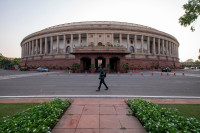Opinion
Water diplomacy
Nepal, China, and India have witnessed civilisations with diverse religions, cultures and heritages growing in harmony but with a brutal history of colonisation followed by periodic shocks.
Pramod Aryal
Nepal, China, and India have witnessed civilisations with diverse religions, cultures and heritages growing in harmony but with a brutal history of colonisation followed by periodic shocks. Moreover, the new global order of the 21st century makes it prudent for these great civilisations to work to harness the embedded potentials for coexistence. Thus, diplomacy has to evolve where peace and harmony is paramount. The Nepal-China Think Tank Conference held in Kathmandu with 14 Chinese members including political and infrastructure experts that coincided with the Raisaina-Observer Research Foundation Conference held in Delhi with three Chinese academicians could have been good gesture.
However, the Delhi gathering had military commanders of the United States Pacific Command (USPACOM) and Naval Forces Europe-Africa along with UK Joint Forces Commander, French Ministry of Defence Deputy Director of Directorate General for International Relations, Vietnam Deputy Chief of Staff, Western India Naval Commander, Thailand Deputy Security General of Security Council, and a Sri Lankan minister with a military background which should indicate a volume.
What does research indicate?
Scientists say that planet warming caused by anthropogenic activities has led to around 15 percent of Tibetan snow melting in the past two decades. And a recent study by the International Centre for Integrated Mountain Development (ICIMOD) has revealed that around 50 percent of the present Dudh Koshi glacier basin in the Everest region will melt by 2050 if the warming persists. Moreover, areas fed by rivers originating in Tibet have observed a reduction of 50 percent per capita of available renewal water resources since 1972, requiring more synergy in water management to avoid riparian conflicts.
In addition, the projected population increase to 9 billion by 2050 as per estimates of the Food and Agriculture Organisation, demands an increase in global agriculture yields of more than 60 percent. The developing countries in Asia that rely on water from rivers originating in Tibet house a substantial number of people. This clearly brings Nepal, China, and India even closer to formulate policies to address the challenges related to environment, population, and prosperity.
China’s south-north water diversion project has raised some eyebrows in the region. A growing population, industrialisation, and expanded agriculture demand more water. River diversion projects were initiated as China’s population concentrated on the East Coast, and as a result areas west of it began demanding more water. This has also raised worries among countries in the Mekong Delta. China’s engagement with these countries to reduce their concern is highly appreciable. Its recent White Paper on the South China Sea reflects its desire to work with the countries in that area.
Myanmar is still comfortable with renewable water availability, but its projected economic growth will demand more. Thus, the Salween River could be of concern and it has to work with China. Moreover, management of the Irrawaddy River could be vital in India’s quest for its river linking project that includes the Brahmaputra and the Ganges. This could impact Bangladesh, raising concern about a possible drop in the amount of water entering the country. It has already publicised the effects of the Farakka Barrage, and India is engaged with Bangladesh in its river linking project.
Nepali partnership bodes well
Nepal could be a good partner to develop these projects, since 45 percent of the Ganges water is supplied by Nepal in the lean season. This could be vital in devising strategies to harness monsoon water with storage dams. For western India, the water of the Jamuna cannot be diverted as 44 percent of it is used for irrigation, and the shrinking flow of the Sutlej has already created a rift between the Indian states of Punjab and Haryana. As these areas are India’s major breadbasket, this change will definitely make policymakers in Delhi think about alternatives. Here, the Sharada (Mahakali) and Karnali rivers could play a major role, as the Karnali has more water than the Jamuna and could potentially irrigate western India and Gujarat. Diverting water from the Gandaki and Koshi can balance the water deficit in the Ganges for diversion to support the Mahanadi Krishna link in the south.
The Chinese population is expected to plateau in 2040 after reaching 1.4 billion. Similarly, the Indian population is projected to surpass the Chinese population by 2030 and continue to grow for some time. This demands a huge rise in farm productivity. Both China and India have seen a 44-48 percent increase in the use of nitrogen fertiliser in this century. They consume more than 50 percent of the global ammonia output. However, climate change has resulted in desertification and drought. The periodic El Niño effect has led to changes in monsoon patterns and impacted Asian agricultural yield.
Proper planning of irrigation facilities is needed both north and south of the Himalaya. Relocation of industries in central and western China could relieve pressure on the Mekong and Salween due to optimal utilisation of the Yangtze in the east. Except for building run-of-the-river type hydro projects, China should refrain from damming major rivers south of the Himalaya like the Indus, Ganges, and Brahmaputra. India should work with Myanmar in the management of the Irrawaddy and divert some water towards Bangladesh so that the Brahmaputra and Ganges waters can be channelled towards south India. Nepal can work with China and India to develop river management infrastructure and implement river linking projects. Linking Indian rivers will definitely involve the One Belt, One Road (OBOR) initiative. China and India can work to use the China-Pakistan Economic Corridor (CPEC) to benefit commerce in western India. A South Asian OBOR initiative involving Bangladesh, Bhutan, China, India and Myanmar should be devised. This could bring prosperity to the region.
Aryal holds a post-doctorate from Vanderbilt University, US




 8.12°C Kathmandu
8.12°C Kathmandu








%20(1).jpg&w=300&height=200)

